Gainsborough Pictures was a British film studio based on the south bank of the Regent's Canal, in north London. Gainsborough Studios was active between 1924 and 1951. The company was initially based at Islington Studios. Other films were made at Lime Grove and Pinewood Studios. The studio is best remembered for the Gainsborough melodramas it produced in the 1940s with such stars as Margaret Lockwood, James Mason and Stewart Granger.

British postcard in the Picturegoer Series, London, no. 151. Photo: Gainsborough.
Gifted English actor James Mason (1909-1984) played in 150 British and American (TV) films and was three times nominated for an Oscar. His distinctive voice enabled him to play a menacing villain as greatly as his good looks assisted him as a matinee idol with a dark side.

British postcard by Real Photograph, no. 250. Sent by mail in 1948. Photo: publicity still for Madonna of the Seven Moons (Arthur Crabtree, 1945).
English film, stage and television actress Phyllis Calvert (1915-2002) was one of the leading stars of the Gainsborough drawing-room comedies and costume melodramas, which helped to put the British film industry on the map immediately after World War II. At the time she was voted in polls as Britain's second most popular actress, behind Margaret Lockwood. Her 70-year film career had started already in the silent era and ended in 1997.

British Postcard, no. F.S. 31. Stewart Granger in Saraband for Dead Lovers (Basil Dearden, 1948).
English actor Stewart Granger (1913–1993) became Britain's top box office star in the 1940s which attracted Hollywood's attention. Tall, dark, dignified and handsome, Granger made over 60 films but is mainly associated with heroic and romantic leading roles. He was quoted: “I've never done a film I'm proud of”.
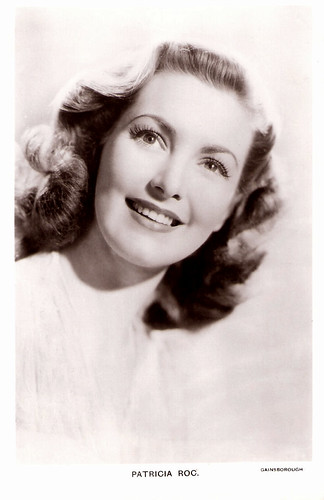
British postcard in the Picturegoer Series, London, nr. W 145. Photo: Gainsborough.
Fresh-faced Patricia Roc (1915-2003) was between 1943 and 1953 one of Britain's top 10 box office stars. The elegant, well spoken actress seemed the epitome of the English rose. She had international success in such Gainsborough costume dramas as Madonna of the Seven Moons (1945) and The Wicked Lady (1945), and in When the Bough Breaks (1947), in which she played an unmarried mother.
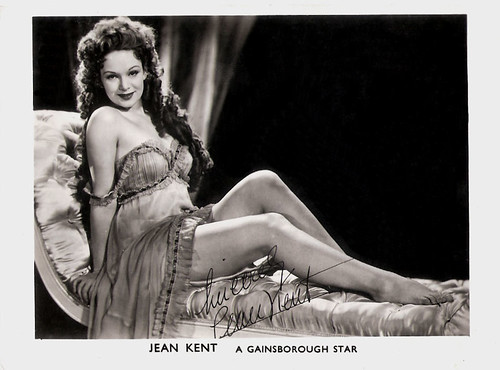
British collectors card. Photo: Gainsborough.
Jean Kent (1921-2013) was a strawberry-blonde British actress who played spiteful hussies or femmes fatales in British films of the 1940s and 1950s.
Gainsborough was founded in 1924 by producer Michael Balcon and director Graham Cutts. In 1927, Gainsborough became associated to Gaumont-British, which was set up by the Ostrer brothers. Balcon became director of production for both studios. Gaumont-British, the mother company based at Shepherd's Bush produced the 'quality' pictures, while Gainsborough mainly produced B films and melodramas at its Islington Studios.
Both studios used continental film practices, especially those from Germany. Alfred Hitchcock was encouraged by Balcon, who had links with Ufa, to study there and make multilingual co-production films with Ufa, before the war. Gainsborough also specialised in the production of multilingual films in the late 1920s and early 1930s.
After the rise of Adolph Hitler, both Balcon's companies offered employment to artists who left Nazi-Germany, including Conrad Veidt, Elisabeth Bergner, art director Alfred Junge, cinematographer Mutz Greenbaum and screenwriter/director Berthold Viertel,.
The studio's opening logo was of a lady (Glennis Lorimer) in a Georgian era period costume sitting in an ornate frame, turning and smiling, based on the famous portrait of Sarah Siddons by Thomas Gainsborough. The short piece of music was written by Louis Levy and called 'the Gainsborough Minuet'.
After the departure of Balcon to MGM-British in 1936, the Rank Organisation gained an interest in Gainsborough. Maurice Ostrer became more involved in production, and producer Ted Black was more influential in the running of the studio. Black had an unerring sense of British popular taste, and production was skewed to the home market with such films as Oh, Mr Porter! (Marcel Varnel, 1937) starring Will Hay, and Owd Bob (Robert Stevenson, 1938). Another hit for the studio was The Lady Vanishes (Alfred Hitchcock, 1938) with Michael Redgrave and Margaret Lockwood.

British postcard in the Picturegoer Series, London, no. 782. Photo: Gainsborough.
British actor Jack Hulbert (1892-1978) was a popular comedian of the 1930s with a trademark chiselled chin. In his musicals he often appeared with his wife Cicely Courtneidge.

British postcard in the Film Partners Series, no. P 42. Photo: Gainsborough Pictures. Jack Hulbert and Cicely Courtneidge in Jack's the Boy (Walter Forde, 1932).
British actress Cicely Courtneidge (1893-1980) was an elegantly knockabout comedienne. For 62 years, she formed a husband and wife team with comedian Jack Hulbert on stage, radio, TV and in the cinema. During the 1930s she also starred in eleven British films and one disastrous American production.

British postcard in the Picturegoer Series, London, no. 785. Photo: Gainsborough. Dorothy Hyson in Soldiers of the King (Maurice Elvey, 1933)
American actress Dorothy Hyson (1914–1996) led a successful stage and film career in London. Noted for her great beauty and striking looks, the songwriters Rogers and Hart dedicated their song, The Most Beautiful Girl in the World, to her. She was a byword for theatrical West End glamour, but also worked as a cryptographer for the secret service during the war.

British postcard in the Film Partners series, London, no. P 72. Photo: Gainsborough.
Ladylike British actress Edna Best (1900-1974) entered films in 1921. She is best remembered as the mother in the original version of Alfred Hitchcock's The Man Who Knew Too Much (1934) and as the second wife of film star Herbert Marshall. She worked both on stage and in the cinema, in the United Kingdom and in the United States.
Herbert Marshall (1890-1966), was a popular English cinema and theatre actor. He overcame the loss of a leg in World War I to enjoy a long career in Hollywood, first as a romantic lead opposite stars like Marlene Dietrich and Greta Garbo, later as a fine character actor.

British postcard in the Picturegoer Series, London, no. 473b. Photo: Gainsborough. George Arliss in Doctor Syn (Roy William Neill, 1937).
George Arliss (1868-1946) was the first British actor to win an Academy Award. He was also an author, a playwright, and a Hollywood film maker with an unusual amount of creative control.
By 1937, Gaumont-British were in financial crisis, and closed their Lime Grove studios, moving all production to the Islington Poole Street studio. However, the tall factory chimney on the site was considered dangerous in the event of bombing during World War II, and thus Gainsborough Studios were evacuated to Lime Grove for the duration of hostilities.
With the outbreak of war, Gainsborough was poised to dominate the popular market. Rank had a hands-off policy on the company, and the Ostrers gave Ted Black his head in the orchestration of film topics. From 1942, a crucial figure in the Gainsborough production team was R.J. Minney, a successful novelist and former Hollywood scriptwriter. Minney and Black inaugurated a series of visually extravagant and morally ambivalent costume melodramas at Gainsborough which dominated the domestic market from 1942 to 1946.
These costume melodramas were based on recent popular books by female novelists, foregrounding gypsies, wanton women and lustful aristocrats. They were made into films which mined a rich seam in British popular culture: films such as The Man in Grey (Leslie Arliss, 1943) starring James Mason, Fanny by Gaslight (1944), Madonna of the Seven Moons (Arthur Crabtree, 1944) with Phyllis Calvert, The Wicked Lady (Leslie Arliss, 1945) featuring Margaret Lockwood, and Caravan (Arthur Crabtree, 1946), starring Stewart Granger and Jean Kent.
Black and Minney encouraged the careers of a new breed of British stars, including Margaret Lockwood, James Mason, Stewart Granger, Phyllis Calvert, Jean Kent, Anne Crawford, Dennis Price, and Patricia Roc. Critics and male viewers excoriated the Gainsborough costume melodramas, but the female side of the British audience took them to their hearts.
The studio also specialised in comedies and modern-dress melodramas. Popular melodramas such as Love Story (Leslie Arliss, 1944), and They Were Sisters (Arthur Crabtree, 1945) dealt with desire, anger and sartorial envy. The comedies including Time Flies (Walter Forde, 1944) starring Tommy Handley, Bees in Paradise (Val Guest, 1944) with Arthur Askey were less popular at the box office.
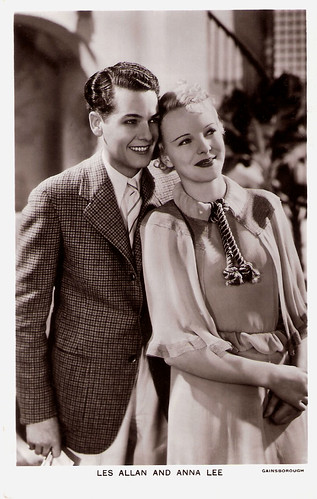
British postcard in the Film Partners Series, London, no. P 182. Photo: Gainsborough. Anna Lee and Les Allen in Heat Wave (Maurice Elvey, 1935).
Blue-eyed blonde Anna Lee (1913-2004) was a British-born American actress. She started her career in British films and earned the title 'Queen of the Quota Quickies'. In 1939, she moved to Hollywood with her husband, director Robert Stevenson. There she often worked with John Ford, and later became a TV star in the soap General Hospital.
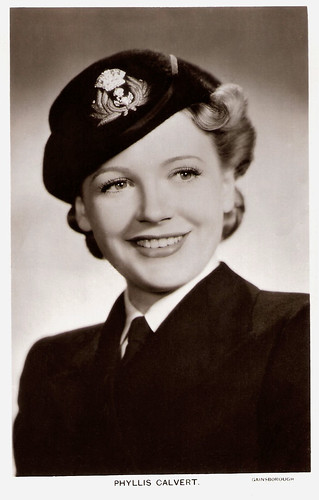
British postcard in the Picturegoer Series, London, no. W 131. Photo: Gainsborough. Phyllis Calvert in The Man in Grey (Leslie Arliss, 1943).

British postcard in the Our Postcard Series, 1948. Photo: Margaret Lockwood in Jassy (Bernard Knowles, 1947).
Beautiful stage and film actress Margaret Lockwood (1916-1990) was the female lead of the early Hitchcock classic The Lady Vanishes (1938). In the 1940s she became Britain's leading box-office star specialising in beautiful but diabolical adventuresses.
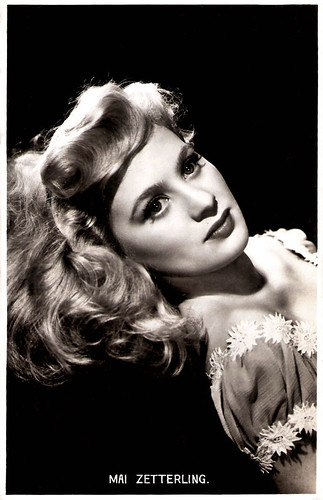
British postcard, no. F.S. 30. Mai Zetterling in Quartet (Ralph Smart, a.o., 1948), a Sydney Box production for Gainsborough Pictures.
Lovely Swedish actress and film director Mai Zetterling (1925-1994) graced many European films in the 1940s and 1950s with her slim figure, green eyes, blonde hair and bewitchingly elfin features.

British postcard by Real Photograph, no. F.S. 29. Photo: Gainsborough Pictures. Dennis Price in The Bad Lord Byron (David MacDonald, 1949).
British actor Dennis Price (1915-1973) made nearly 130 films and television plays. He started as a suave leading man, and became a character star of great versatility.
Sue Harper in the Encyclopedia of British Film: "After 1946, Rank's henchmen began to intervene more directly in production, and one by one the disillusioned Gainsborough specialists left. The Ostrers resigned, Black went to MGM, Minney left film production and Rank wished to appoint a successor who would continue their popular melodrama trajectory.
He chose Sydney Box, mistakenly thinking that his The Seventh Veil (Compton Bennett, 1945) provided the right pedigree. But Box was essentially interested in verisimilitude of method and appearance. Films such as Here Come the Huggetts (Ken Annakin, 1948), and A Boy, a Girl and a Bike (Ralph Smart, 1949) were predicated on social realism. Box's output was uneven, and he was hampered by inexperience, bad planning and expensive location work. Gainsborough's dominance at the box-office declined drastically, and Rank cut his losses by closing the studio in 1950."
However, Box ushered in some important innovations in film practice. He appointed his sister Betty Box as producer at the Islington arm of Gainsborough, and gave her sufficient autonomy to develop a substantial career. As the only female producer in British cinema at the time, she oversaw such films as the neo-realist Holiday Camp (Ken Annakin, 1947), which introduced the Huggett family and started a successful series, starring Jack Warner, Kathleen Harrison, and Petula Clark, and the mermaid comedy Miranda (Ken Annakin, 1948) featuring Glynis Johns.
Sue Harper: "Sydney Box also furthered the career of his wife Muriel Box while at Gainsborough, promoting her to head of the Scenario Department. Muriel wrote a number of ground-breaking scripts, in which her feminism was much in evidence. Such films as The Brothers (David McDonald, 1947) and Good-Time Girl (David McDonald, 1948) have scripts which nuance female desire and its punishment in an unusually explicit way."
Unhappy with the performance of the studio, Rank closed it down in early 1949. Production was concentrated at Pinewood Studios. Although at first films continued to be made there under the Gainsborough banner, this quickly stopped and no further Gainsborough films were released after 1951.
The original Lime Grove site was taken over by the BBC in 1949 and remained in use until it was closed in 1991. The buildings were demolished in the early 1990s, and have been since replaced with housing presently called Gaumont Terrace and Gainsborough Court. The former Islington Studios, in Poole Street, remained largely derelict after their closure in 1949 apart from occasional art performances. The studios were demolished in 2002 and replaced by three blocks of upmarket apartments in 2004.

British postcard in the Picturegoer Series, London, no. 1217. Photo: Gainsborough.
Sir Michael Redgrave (1908-1985) was an English stage and film actor, who started starring in a Hitchcock classic and went on to star in many British and some Hollywood productions. He was the father of Vanessa, Lynn and Corin Redgrave.
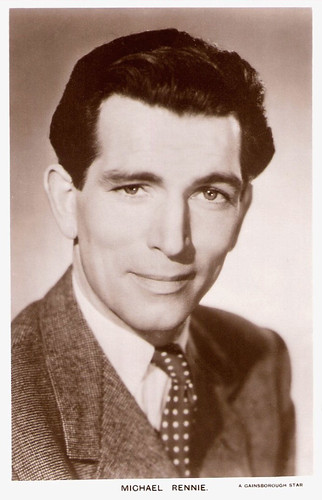
British postcard. Photo: Gainsborough.
English film, television, and stage actor Michael Rennie (1909-1971) was best known for his starring role as the space visitor Klaatu in the Science Fiction classic The Day the Earth Stood Still (1951).

British postcard. Photo: Gainsborough. Jean Kent.

British postcard. Photo: Gainsborough. Phyllis Calvert.
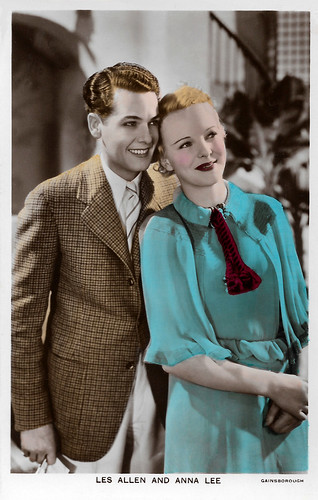
British postcard in the Film Partners Series, London, no. P 182. Photo: Gainsborough. Anna Lee and Les Allen in Heat Wave (Maurice Elvey, 1935).
Sources: Sue Harper (BFI Screenonline), Wikipedia and IMDb.

British postcard in the Picturegoer Series, London, no. 151. Photo: Gainsborough.
Gifted English actor James Mason (1909-1984) played in 150 British and American (TV) films and was three times nominated for an Oscar. His distinctive voice enabled him to play a menacing villain as greatly as his good looks assisted him as a matinee idol with a dark side.

British postcard by Real Photograph, no. 250. Sent by mail in 1948. Photo: publicity still for Madonna of the Seven Moons (Arthur Crabtree, 1945).
English film, stage and television actress Phyllis Calvert (1915-2002) was one of the leading stars of the Gainsborough drawing-room comedies and costume melodramas, which helped to put the British film industry on the map immediately after World War II. At the time she was voted in polls as Britain's second most popular actress, behind Margaret Lockwood. Her 70-year film career had started already in the silent era and ended in 1997.

British Postcard, no. F.S. 31. Stewart Granger in Saraband for Dead Lovers (Basil Dearden, 1948).
English actor Stewart Granger (1913–1993) became Britain's top box office star in the 1940s which attracted Hollywood's attention. Tall, dark, dignified and handsome, Granger made over 60 films but is mainly associated with heroic and romantic leading roles. He was quoted: “I've never done a film I'm proud of”.

British postcard in the Picturegoer Series, London, nr. W 145. Photo: Gainsborough.
Fresh-faced Patricia Roc (1915-2003) was between 1943 and 1953 one of Britain's top 10 box office stars. The elegant, well spoken actress seemed the epitome of the English rose. She had international success in such Gainsborough costume dramas as Madonna of the Seven Moons (1945) and The Wicked Lady (1945), and in When the Bough Breaks (1947), in which she played an unmarried mother.

British collectors card. Photo: Gainsborough.
Jean Kent (1921-2013) was a strawberry-blonde British actress who played spiteful hussies or femmes fatales in British films of the 1940s and 1950s.
B films and melodramas
Gainsborough was founded in 1924 by producer Michael Balcon and director Graham Cutts. In 1927, Gainsborough became associated to Gaumont-British, which was set up by the Ostrer brothers. Balcon became director of production for both studios. Gaumont-British, the mother company based at Shepherd's Bush produced the 'quality' pictures, while Gainsborough mainly produced B films and melodramas at its Islington Studios.
Both studios used continental film practices, especially those from Germany. Alfred Hitchcock was encouraged by Balcon, who had links with Ufa, to study there and make multilingual co-production films with Ufa, before the war. Gainsborough also specialised in the production of multilingual films in the late 1920s and early 1930s.
After the rise of Adolph Hitler, both Balcon's companies offered employment to artists who left Nazi-Germany, including Conrad Veidt, Elisabeth Bergner, art director Alfred Junge, cinematographer Mutz Greenbaum and screenwriter/director Berthold Viertel,.
The studio's opening logo was of a lady (Glennis Lorimer) in a Georgian era period costume sitting in an ornate frame, turning and smiling, based on the famous portrait of Sarah Siddons by Thomas Gainsborough. The short piece of music was written by Louis Levy and called 'the Gainsborough Minuet'.
After the departure of Balcon to MGM-British in 1936, the Rank Organisation gained an interest in Gainsborough. Maurice Ostrer became more involved in production, and producer Ted Black was more influential in the running of the studio. Black had an unerring sense of British popular taste, and production was skewed to the home market with such films as Oh, Mr Porter! (Marcel Varnel, 1937) starring Will Hay, and Owd Bob (Robert Stevenson, 1938). Another hit for the studio was The Lady Vanishes (Alfred Hitchcock, 1938) with Michael Redgrave and Margaret Lockwood.

British postcard in the Picturegoer Series, London, no. 782. Photo: Gainsborough.
British actor Jack Hulbert (1892-1978) was a popular comedian of the 1930s with a trademark chiselled chin. In his musicals he often appeared with his wife Cicely Courtneidge.

British postcard in the Film Partners Series, no. P 42. Photo: Gainsborough Pictures. Jack Hulbert and Cicely Courtneidge in Jack's the Boy (Walter Forde, 1932).
British actress Cicely Courtneidge (1893-1980) was an elegantly knockabout comedienne. For 62 years, she formed a husband and wife team with comedian Jack Hulbert on stage, radio, TV and in the cinema. During the 1930s she also starred in eleven British films and one disastrous American production.

British postcard in the Picturegoer Series, London, no. 785. Photo: Gainsborough. Dorothy Hyson in Soldiers of the King (Maurice Elvey, 1933)
American actress Dorothy Hyson (1914–1996) led a successful stage and film career in London. Noted for her great beauty and striking looks, the songwriters Rogers and Hart dedicated their song, The Most Beautiful Girl in the World, to her. She was a byword for theatrical West End glamour, but also worked as a cryptographer for the secret service during the war.

British postcard in the Film Partners series, London, no. P 72. Photo: Gainsborough.
Ladylike British actress Edna Best (1900-1974) entered films in 1921. She is best remembered as the mother in the original version of Alfred Hitchcock's The Man Who Knew Too Much (1934) and as the second wife of film star Herbert Marshall. She worked both on stage and in the cinema, in the United Kingdom and in the United States.
Herbert Marshall (1890-1966), was a popular English cinema and theatre actor. He overcame the loss of a leg in World War I to enjoy a long career in Hollywood, first as a romantic lead opposite stars like Marlene Dietrich and Greta Garbo, later as a fine character actor.

British postcard in the Picturegoer Series, London, no. 473b. Photo: Gainsborough. George Arliss in Doctor Syn (Roy William Neill, 1937).
George Arliss (1868-1946) was the first British actor to win an Academy Award. He was also an author, a playwright, and a Hollywood film maker with an unusual amount of creative control.
Gypsies, wanton women and lustful aristocrats
By 1937, Gaumont-British were in financial crisis, and closed their Lime Grove studios, moving all production to the Islington Poole Street studio. However, the tall factory chimney on the site was considered dangerous in the event of bombing during World War II, and thus Gainsborough Studios were evacuated to Lime Grove for the duration of hostilities.
With the outbreak of war, Gainsborough was poised to dominate the popular market. Rank had a hands-off policy on the company, and the Ostrers gave Ted Black his head in the orchestration of film topics. From 1942, a crucial figure in the Gainsborough production team was R.J. Minney, a successful novelist and former Hollywood scriptwriter. Minney and Black inaugurated a series of visually extravagant and morally ambivalent costume melodramas at Gainsborough which dominated the domestic market from 1942 to 1946.
These costume melodramas were based on recent popular books by female novelists, foregrounding gypsies, wanton women and lustful aristocrats. They were made into films which mined a rich seam in British popular culture: films such as The Man in Grey (Leslie Arliss, 1943) starring James Mason, Fanny by Gaslight (1944), Madonna of the Seven Moons (Arthur Crabtree, 1944) with Phyllis Calvert, The Wicked Lady (Leslie Arliss, 1945) featuring Margaret Lockwood, and Caravan (Arthur Crabtree, 1946), starring Stewart Granger and Jean Kent.
Black and Minney encouraged the careers of a new breed of British stars, including Margaret Lockwood, James Mason, Stewart Granger, Phyllis Calvert, Jean Kent, Anne Crawford, Dennis Price, and Patricia Roc. Critics and male viewers excoriated the Gainsborough costume melodramas, but the female side of the British audience took them to their hearts.
The studio also specialised in comedies and modern-dress melodramas. Popular melodramas such as Love Story (Leslie Arliss, 1944), and They Were Sisters (Arthur Crabtree, 1945) dealt with desire, anger and sartorial envy. The comedies including Time Flies (Walter Forde, 1944) starring Tommy Handley, Bees in Paradise (Val Guest, 1944) with Arthur Askey were less popular at the box office.

British postcard in the Film Partners Series, London, no. P 182. Photo: Gainsborough. Anna Lee and Les Allen in Heat Wave (Maurice Elvey, 1935).
Blue-eyed blonde Anna Lee (1913-2004) was a British-born American actress. She started her career in British films and earned the title 'Queen of the Quota Quickies'. In 1939, she moved to Hollywood with her husband, director Robert Stevenson. There she often worked with John Ford, and later became a TV star in the soap General Hospital.

British postcard in the Picturegoer Series, London, no. W 131. Photo: Gainsborough. Phyllis Calvert in The Man in Grey (Leslie Arliss, 1943).

British postcard in the Our Postcard Series, 1948. Photo: Margaret Lockwood in Jassy (Bernard Knowles, 1947).
Beautiful stage and film actress Margaret Lockwood (1916-1990) was the female lead of the early Hitchcock classic The Lady Vanishes (1938). In the 1940s she became Britain's leading box-office star specialising in beautiful but diabolical adventuresses.

British postcard, no. F.S. 30. Mai Zetterling in Quartet (Ralph Smart, a.o., 1948), a Sydney Box production for Gainsborough Pictures.
Lovely Swedish actress and film director Mai Zetterling (1925-1994) graced many European films in the 1940s and 1950s with her slim figure, green eyes, blonde hair and bewitchingly elfin features.

British postcard by Real Photograph, no. F.S. 29. Photo: Gainsborough Pictures. Dennis Price in The Bad Lord Byron (David MacDonald, 1949).
British actor Dennis Price (1915-1973) made nearly 130 films and television plays. He started as a suave leading man, and became a character star of great versatility.
The only female producer in British cinema
Sue Harper in the Encyclopedia of British Film: "After 1946, Rank's henchmen began to intervene more directly in production, and one by one the disillusioned Gainsborough specialists left. The Ostrers resigned, Black went to MGM, Minney left film production and Rank wished to appoint a successor who would continue their popular melodrama trajectory.
He chose Sydney Box, mistakenly thinking that his The Seventh Veil (Compton Bennett, 1945) provided the right pedigree. But Box was essentially interested in verisimilitude of method and appearance. Films such as Here Come the Huggetts (Ken Annakin, 1948), and A Boy, a Girl and a Bike (Ralph Smart, 1949) were predicated on social realism. Box's output was uneven, and he was hampered by inexperience, bad planning and expensive location work. Gainsborough's dominance at the box-office declined drastically, and Rank cut his losses by closing the studio in 1950."
However, Box ushered in some important innovations in film practice. He appointed his sister Betty Box as producer at the Islington arm of Gainsborough, and gave her sufficient autonomy to develop a substantial career. As the only female producer in British cinema at the time, she oversaw such films as the neo-realist Holiday Camp (Ken Annakin, 1947), which introduced the Huggett family and started a successful series, starring Jack Warner, Kathleen Harrison, and Petula Clark, and the mermaid comedy Miranda (Ken Annakin, 1948) featuring Glynis Johns.
Sue Harper: "Sydney Box also furthered the career of his wife Muriel Box while at Gainsborough, promoting her to head of the Scenario Department. Muriel wrote a number of ground-breaking scripts, in which her feminism was much in evidence. Such films as The Brothers (David McDonald, 1947) and Good-Time Girl (David McDonald, 1948) have scripts which nuance female desire and its punishment in an unusually explicit way."
Unhappy with the performance of the studio, Rank closed it down in early 1949. Production was concentrated at Pinewood Studios. Although at first films continued to be made there under the Gainsborough banner, this quickly stopped and no further Gainsborough films were released after 1951.
The original Lime Grove site was taken over by the BBC in 1949 and remained in use until it was closed in 1991. The buildings were demolished in the early 1990s, and have been since replaced with housing presently called Gaumont Terrace and Gainsborough Court. The former Islington Studios, in Poole Street, remained largely derelict after their closure in 1949 apart from occasional art performances. The studios were demolished in 2002 and replaced by three blocks of upmarket apartments in 2004.

British postcard in the Picturegoer Series, London, no. 1217. Photo: Gainsborough.
Sir Michael Redgrave (1908-1985) was an English stage and film actor, who started starring in a Hitchcock classic and went on to star in many British and some Hollywood productions. He was the father of Vanessa, Lynn and Corin Redgrave.

British postcard. Photo: Gainsborough.
English film, television, and stage actor Michael Rennie (1909-1971) was best known for his starring role as the space visitor Klaatu in the Science Fiction classic The Day the Earth Stood Still (1951).

British postcard. Photo: Gainsborough. Jean Kent.

British postcard. Photo: Gainsborough. Phyllis Calvert.

British postcard in the Film Partners Series, London, no. P 182. Photo: Gainsborough. Anna Lee and Les Allen in Heat Wave (Maurice Elvey, 1935).
Sources: Sue Harper (BFI Screenonline), Wikipedia and IMDb.
No comments:
Post a Comment